Related Research Articles

Field hockey is a team sport structured in standard hockey format, in which each team plays with 11 players in total, made up of 10 field players and a goalkeeper. Teams must move a hockey ball around a field by hitting it with a hockey stick towards the rival team's shooting circle and then into the goal. The match is won by the team that scores the most goals. Matches are played on grass, watered turf, artificial turf, or indoor boarded surface. Street hockey is a form of impromptu field hockey typically played by children in Canada, via erecting a net in the street and using the road surface to play.

Floorball is a type of floor hockey with five players and a goalkeeper in each team. It is played indoors with 96–115.5 cm-long (37.8–45.5 in) sticks and a 70–72 mm-diameter (2.76–2.83 in) plastic ball with holes. Matches are played in three twenty-minute periods. The sport of bandy also played a role in the game's development.
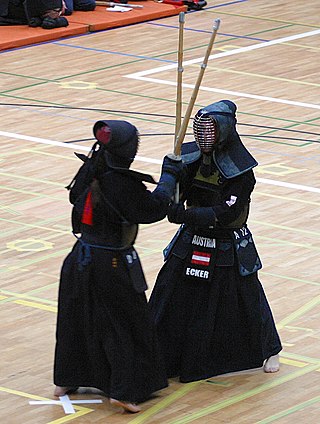
Kendo is a modern Japanese martial art, descended from kenjutsu, that uses bamboo swords (shinai) as well as protective armor (bōgu). It began as samurai warriors' customary swordsmanship exercises, and today it is widely practiced within Japan and has spread to many other nations across the world.

Polo is a ball game that is played on horseback, a traditional field sport and one of the world's oldest known team sports. The game is played by two opposing teams with the objective of scoring using a long-handled wooden mallet to hit a small hard ball through the opposing team's goal. Each team has four mounted riders, and the game usually lasts one to two hours, divided into periods called chukkas or chukkers.

Gaelic football, commonly known as simply Gaelic, GAA or football is an Irish team sport. A form of football, it is played between two teams of 15 players on a rectangular grass pitch. The objective of the sport is to score by kicking or punching the ball into the other team's goal or between two upright posts above the goal and over a crossbar 2.5 metres above the ground.

A referee is an official, in a variety of sports and competition, responsible for enforcing the rules of the sport, including sportsmanship decisions such as ejection. The official tasked with this job may be known by a variety of other titles depending on the sport, including umpire, judge, arbiter (chess), commissaire, or technical official. Referees may be assisted by umpires, linesmen, timekeepers, touch judges, or video review officials.

Floor hockey is a broad term for several indoor floor game codes which involve two teams using a stick and type of ball or disk. Disks are either open or closed but both designs are usually referred to as "pucks". These games are played either on foot or with wheeled skates. Variants typically reflect the style of ice hockey, field hockey, bandy or some other combination of sport. Games are commonly known by various names including cosom hockey, ball hockey, floorball, or simply floor hockey.

Cycle polo, bicycle polo, or bike polo is a team sport, similar to traditional polo, except that bicycles are used instead of horses. There are two versions of the sport: Hardcourt Bike Polo and grass court bike polo. The hardcourt game saw a sharp spike in interest in the first decade of the 21st century and new teams are sprouting up across the world in China, Canada, Ireland, Switzerland, France, India, Germany, Pakistan, Ukraine, Russia, Malaysia, Sri Lanka, Indonesia, Hungary, Australia, New Zealand, Sweden, England, Scotland, Argentina, Italy, Spain, United States, Poland, Croatia, Slovenia, Lithuania, Nepal, Brazil and Cuba.
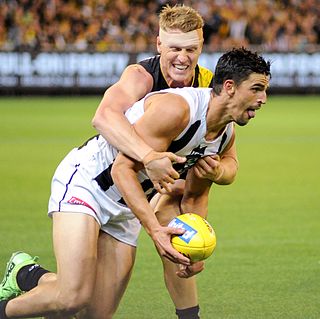
A contact sport is any sport where physical contact between competitors, or their environment, is an integral part of the game. For example, gridiron football. Contact may come about as the result of intentional or incidental actions by the players in the course of play. This is in contrast to noncontact sports where players often have no opportunity to make contact with each other and the laws of the game may expressly forbid contact. In contact sports some forms of contact are encouraged as a critical aspect of the game such as tackling, while others are incidental such as when shielding the ball or contesting an aerial challenge. As the types of contact between players is not equal between all sports they define the types of contact that is deemed acceptable and fall within the laws of the game, while outlawing other types of physical contact that might be considered expressly dangerous or risky such as a high tackle or spear tackle, or against the spirit of the game such as striking below the belt or other unsportsmanlike conduct. Where there is a limit as to how much contact is acceptable most sports have a mechanism to call a foul by the referee, umpire or similar official when an offence is deemed to have occurred.
Indian martial arts refers to the fighting systems of the Indian subcontinent. A variety of terms are used for the English phrases "Indian martial arts", deriving from ancient sources. While they may seem to imply specific disciplines, by Classical times they were used generically for all fighting systems.
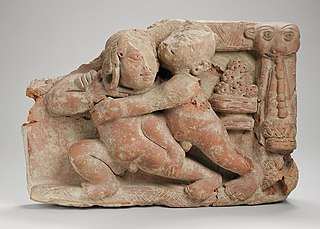
Malla-yuddha is the traditional form of combat-wrestling originating in the Indian subcontinent. It is closely related to Southeast Asian wrestling styles such as naban and is one of the two ancestors of kushti. Indian wrestling is described in the 13th century Malla Purana.
Mini hockey or Minkey is a modified form of field hockey designed for primary school children.
Mukna is a form of folk wrestling from the north-east Indian state of Manipur. It is popular in Imphal, Thoubal and Bishnupur. The game is generally played on the last day of the Lai Haraoba festival and is an intrinsic part of the ceremonial functions.

Huiyen Lallong is a traditional Meitei martial art form. It is one of the Indian martial arts, originating from Manipur. In the Meitei language, Huiyen means war while Lallong or Lanlong can mean net, knowledge or art. Huiyen Langlon consists of two main subforms: Thang-Ta and Sarit Sarak. The primary weapons of Huiyen Lallong are the Thang (sword) and Ta (spear). The spear can be used in its non-missile form while up close, or thrown from afar. Other weapons include the shield and the axe. Unarmed combat incorporates hand strikes, kicks, and grappling (Mukna). Because of Manipur's cultural similarity and geographical proximity with Myanmar, huyen langlon is closely related to Burmese bando and banshay.

This list is an alphabetical glossary of Australian rules football terms, jargon and slang. While some of these entries are shared with other sports, Australian rules football has developed a unique and rich terminology.
Yubi lakpi is a seven-a-side traditional football game played in Manipur, India, using a coconut, which has some notable similarities to rugby. Despite these similarities, the name is not related to the game of rugby or Rugby School in England, it is in fact of Meitei-Pangal origin, and means literally "coconut snatching". Emma Levine, an English writer on little known Asian sports, speculates:

India is the birthplace of modern polo. The modern game of polo is derived from Manipur, where the game was known as sagol kangjei, kanjai-bazee, or pulu. It was the anglicised form of the last, referring to the wooden ball that was used, which was adopted by the sport in its slow spread to the west.
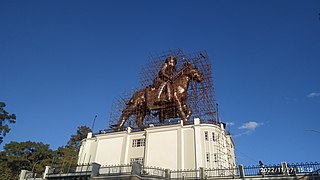
Manipur is home to a population playing many different sports.

Marjing is the God of horses, polo, hockey, sports and war in Sanamahism, the indigenous religion of Manipur. The guardianship of the north eastern direction is alluded to Marjing and the other directions to Koupalu, Thangching and Wangpulen. According to the legend, he invented the game of polo and introduced it as the national game. He and his divine creature, Samadon Ayangba, reside in the top of the Heingang Ching.
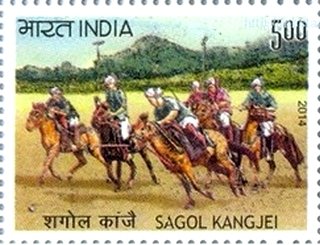
Sagol Kangjei is a traditional Meitei ball sport played on horseback with a long-handled stick. The sport, also known as Manipuri polo, is a predecessor of modern international polo.
References
- Doshi, Saryu (1989). Dances of Manipur: The Classical Tradition. Marg Publications. ISBN 9788185026091.
- Fazili, Asif Iqbal; Ashraf, S Husain (2006). Tourism In India Planning & Development. Encyclopaedia of World Geography. Vol. 17 (1 ed.). Sarup & Sons. ISBN 9788176256650.
- Folklore. Vol. 2. Indian Publications. 1961.
- Green, Thomas A.; Svinth, Joseph R. (2010). Martial Arts of the World: An Encyclopedia of History and Innovation. Martial Arts of the World: Regions and individual arts. Vol. 1. ABC-CLIO. ISBN 9781598842432.
- Hodson, Thomas Callan (1908). The Meitheis. London: David Nutt. OCLC 63942822. OL 23534254M.
- Prakash, Col Ved (2007). Encyclopaedia of North-East India. Vol. 4. Atlantic Publishers & Distributors. ISBN 9788126907069.
- Singh, Moirangthem Kirti (1980). Religious developments in Manipur in the 18th and 19th centuries. Manipur State Kala Akademi.
